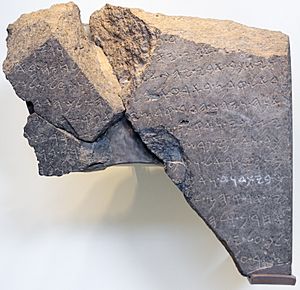Tel Dan stele facts for kids
Quick facts for kids Tel Dan Stele |
|
|---|---|

|
|
| Material | Basalt |
| Writing | Old Aramaic (Phoenician alphabet) |
| Created | 870–750 BCE |
| Discovered | 1993–94 |
| Present location | Israel Museum |
The Tel Dan Stele is a broken stone slab with an ancient writing on it. This writing is in a language called Old Aramaic. It was made around the 9th century BCE, which is over 2,800 years ago!
This stele is very important because it's the oldest known ancient object found outside the Hebrew Bible that mentions the "House of David." This refers to the family line of David, a famous king from ancient times.
Archaeologists found the Tel Dan Stele in 1993 at a place called Tel-Dan. It was discovered by Gila Cook, who was part of a team led by Avraham Biran. The pieces of the stele were actually used as part of an old stone wall. The writing on the stele talks about a person who killed Jehoram, the King of Israel, and Ahaziah of Judah, a king from the House of David. Today, you can see the stele at the Israel Museum.
The words on the stele match some stories in the Hebrew Bible. For example, the Second Book of Kings mentions that Jehoram was the son of Ahab, an Israelite king. The stele was likely set up by Hazael, the king of Aram-Damascus. He spoke Old Aramaic, the language on the stele. The Bible also says that Hazael conquered Israel but not Jerusalem.
Contents
How the Stele Was Found
The first piece of the stele, called Fragment A, was found in July 1993. It was discovered by Gila Cook while she was exploring Tel Dan in northern Israel. Later, in June 1994, two more pieces, Fragments B1 and B2, were found.
The stele wasn't found in its original spot. Instead, its pieces were reused to build a wall. This is called "secondary use" in archaeology. It means the stone was moved and used again for something else after its first purpose.
The archaeologists Avraham Biran and Joseph Naveh shared their findings about the stele in 1993 and 1995.
What the Stele Says
The Tel Dan stele is made of several broken pieces. Together, they form part of a victory message written in Old Aramaic. Most experts believe this message was left by Hazael, the king of Aram-Damascus. He was a very powerful leader in the late 9th century BCE.
The king who wrote the message brags about his wins. He claims to have defeated the king of Israel and his ally, the king from the "House of David." The words "House of David" (Imperial Aramaic: 𐤁𐤉𐤕𐤃𐤅𐤃, romanized: bytdwd) are very important. This stele is widely accepted as the earliest mention of King David's family outside of the Hebrew Bible.
Some scholars have debated the meaning of "House of David." This is because there isn't a clear space between the words "byt" (house) and "dwd" (David). However, most experts agree that it refers to the family of David.
The Tel Dan stele is one of only a few ancient writings that mention the name "Israel" from that time. The others are the Merneptah Stele, the Mesha Stele, and the Kurkh Monoliths.
Many articles have been written about the Tel Dan inscription. People have discussed its age, who wrote it, and if it's real. But most scholars now agree that the stele is real and truly mentions the House of David.
Kings and Kingdoms Mentioned
The writing on the stele talks about fights with the kings of Israel and the 'House of David'. The names of the two enemy kings are partly missing. But archaeologists Biran and Naveh believe they were Joram, son of Ahab, King of Israel, and Ahaziah, son of Joram of the House of David. Not all experts fully agree on these names, as it depends on how the broken pieces are put together.
In the reconstructed text, the writer says that Israel invaded his country when his father was king. Then, the god Hadad made him king and helped him fight against Israel. The writer then claims to have defeated many kings with thousands of chariots and horses. The last line might suggest a siege, possibly of Samaria, which was the capital of the kings of Israel. However, this part is also debated by scholars.
Images for kids
See also
- Historicity of David
- List of artifacts significant to the Bible


